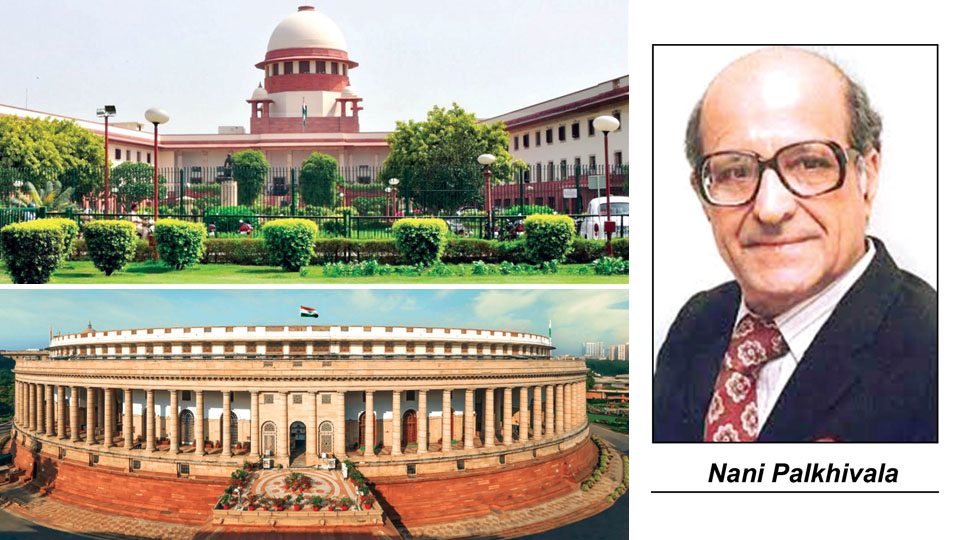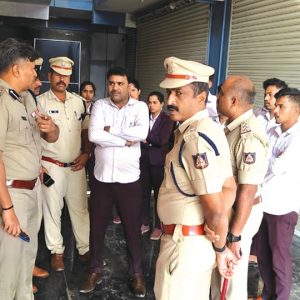By Ravi Joshi, Formerly in the Cabinet Secretariat
It was the summer of 1973, exactly 50 years to this week, and a historic legal battle was being fought in the Supreme Court. The case was known as the Keshavananda Bharati Vs State of Kerala. On 24th April, a 13-Judge Bench delivered the verdict, a landmark judgement in the history of Indian jurisprudence. The arguments ran for 68 days and one of the topmost legal luminaries, Nani Palkhiwala, argued for the Petitioners.
I was in the final year of my MA in Political Science, in Manasagangothri and Prof. K.B.Y. Thotappa, who taught us Political Theory, would often walk into the classroom with ‘The Hindu’ newspaper of the day and start reading out Palkhiwala’s arguments. Then he would explain the principle behind it or the theoretical basis for his arguments. He showed us that what we were studying was actually being applied in settling major political issues of the day. He made the arguments in the Supreme Court come alive to us. Those were fascinating days.
Background
The elections of March 1971 had given Indira Gandhi a landslide victory of 2/3rds majority in the Parliament. She had come to power on the slogan ‘Garibi Hatao’, a socialist agenda and rightly thought the people have voted out the deadwood and were in favour of change. She, therefore decided to remove all obstacles in her path to change the policy direction of the State.
Four years earlier, the Supreme Court in the Golaknath case, in 1967 had questioned whether Fundamental Rights could be amended, particularly in relation to the Right to Property. The Court had declared that Fundamental Rights cannot be subjected to the process of amendment provided in Article 368 and that if any such rights have to be amended a new Constituent Assembly must be convened. Guided by this principle, in the years that followed, the Supreme Court struck down the Bank Nationalisation Act of 1969 and the Presidential Order that aimed at the abolition of Privy Purses, two of the most publicised ‘socialist measures’ of Indira Gandhi.
Following these setbacks, Prime Minister Indira Gandhi got the Parliament to pass the 24th and 25th Constitutional Amendment Acts in November 1971 to nullify the effects of these judgements. The 24th Amendment added new clauses to Articles 13 and 368 that provided full powers to the Parliament to amend or change any or all parts of the Constitution, while the 25th Amendment exempted any law giving effect to Article 39 (b) and (C) of Directive Principles of State Policy from ‘judicial review’ even if it violated the Fundamental Rights.
This was the politico-legal context for the ‘battle royale’ that was to follow in the all-important Keshavananda Bharati case, which was to determine the power of the Judiciary over the Parliament as the ultimate protector and defender of the Constitution.
Meanwhile, the Kerala government under Chief Minister C. Achuta Menon, a communist leader, enacted the Land Reforms Act of 1969 which put an end to the feudal system and ensured the rights of tenants on the land. Under this Act, the State government acquired the land belonging to the Edneer Mutt in the Kasargod district of Kerala.
Challenging the land acquisition, His Holiness Keshavananda Bharati, the head of the Mutt, filed a writ petition under Article 32 for the enforcement of rights under Article 25 (Right to practice and propagate religion), Article 26 (Right to manage religious affairs), Article 14 (Right to Equality), Article 19 (1)(f) (Freedom to acquire property) and Article 31 (Compulsory Acquisition of Property).
The 29th Amendment Act, 1972, placed the Kerala Land Reforms Act 1963 in the Ninth Schedule of the Constitution, thus putting it beyond the purview of judicial review. So, the petitioners in the case challenged the constitutional validity of the 24th, 25th and 29th Amendment Acts.
The Judgement
The Supreme Court by a wafer-thin majority of 7:6 held that the Parliament in the exercise of its constituent power can amend any provision of the Constitution. The court gave the following reasons:
• First, the power to amend the Constitution is located in Article 368.
• Second, neither the Constitution nor an amendment of the Constitution can be or is law within the meaning of Article 13.
• Third, an amendment to the Constitution is an exercise of the constituent power. The majority view in Golaknath case is, with respect, wrong.
• Fourth, there are no implied and inherent limitations on the power of amendment. Neither the Preamble nor Article 31(2) is at all a limitation on the power of amendment.
So, the Court held the 24th Amendment as valid. On the 25th Amendment, the Court upheld the first part but declared the negation of ‘judicial review’ as invalid. In other words, the laws enacted to give effect to the Directive Principles of State Policy are open to Judicial Review. It also held the 29th Amendment as valid but held that the laws included in the Ninth Schedule can be challenged in the court of law on the grounds that they abrogate the basic elements of the Constitutional structure.
On the question as to what extent the Constitution can be amended, the Court pronounced the ‘Doctrine of Basic Structure.’ All amendments to the Constitution, in future, are subjected to the above doctrine. The origins of the ‘basic structure doctrine’ are found in the German Constitution, which after the Nazi regime was amended to protect some basic laws. Here is an illustrative, but not exhaustive, list of the basic structure of the Constitution:
• The Supremacy of the Constitution
• The Sovereignty of India
• Republican and Democratic forms of Government.
• The Secular Character of Constitution
• A Free and Independent judiciary
• Federal Character of the Constitution
Subsequently, the Supreme Court has struck down a Constitutional amendment entirely just once — The Constitution 99th Amendment Act, 2014, which established the National Judicial Appointments Commission (NJAC), the body that would have been responsible for the appointment and transfer of Judges, replacing the current Collegium system citing the ‘Basic Structure doctrine’ relating to ‘Free and Independent Judiciary’. Even after 50 years, the battle between the Parliament and Judiciary continues unabated.








@ Following these setbacks, Prime Minister Indira Gandhi got the Parliament to pass the 24th and 25th Constitutional Amendment Acts in November 1971 to nullify the effects of these judgements. …
Government headed by Mrs. Gandhi introduced following amendments to the Indian Constitution :24th (1971) ( Art 13 & Art 368 ) , 25th ( 1971)( Art 31, Art 39(b), Art 31C) , 26 (abolition of Privy Purse) , 29TH(1972) (expansionism of Ninth schedule) . The Supreme Court reviewed its decision in Golaknath v. State of Punjab, in 1971 in Kesavananda Bharati v. State of Kerala, and considered the validity of the 24th, 25th, 26th and 29th Amendments.
Constitution Bench however left the 26Th amendment to be decided by a 5 Judge Constitution Bench later ! It was only in Raghunathrao Ganpatrao Etc. Etc vs Union Of India on 4 February, 1993 the amendment was upheld!
Keshavananda Case orders on Art 31C were equally ambiguous and it is waiting for an an authoritative opinion before a Nine Judge Bench since 2002 along with Art. 39(b).
Despite all the brouhaha about the basic Structure doctrine and Preamble being part of it, Secular and social continue to remain there !
Some time one wonders why all those Verbose pyrotechnics if the 13 learned men could not sit together give an unambiguous opinion.
Fact remains Right to Property was deleted later despite it being a human right !